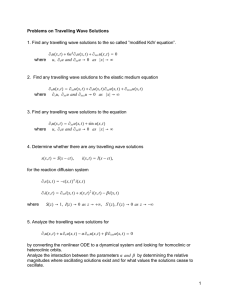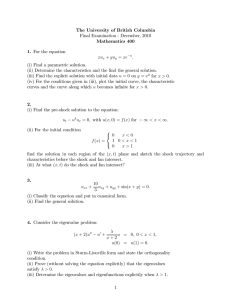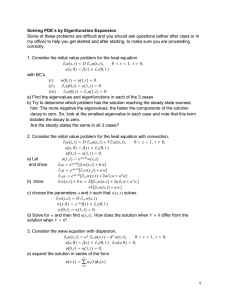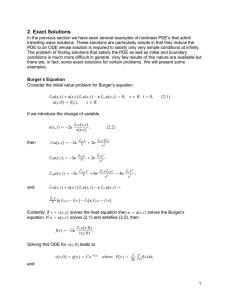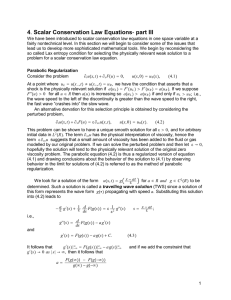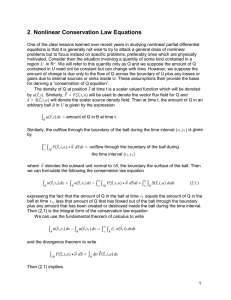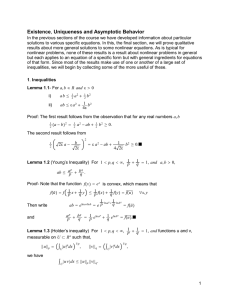3
advertisement
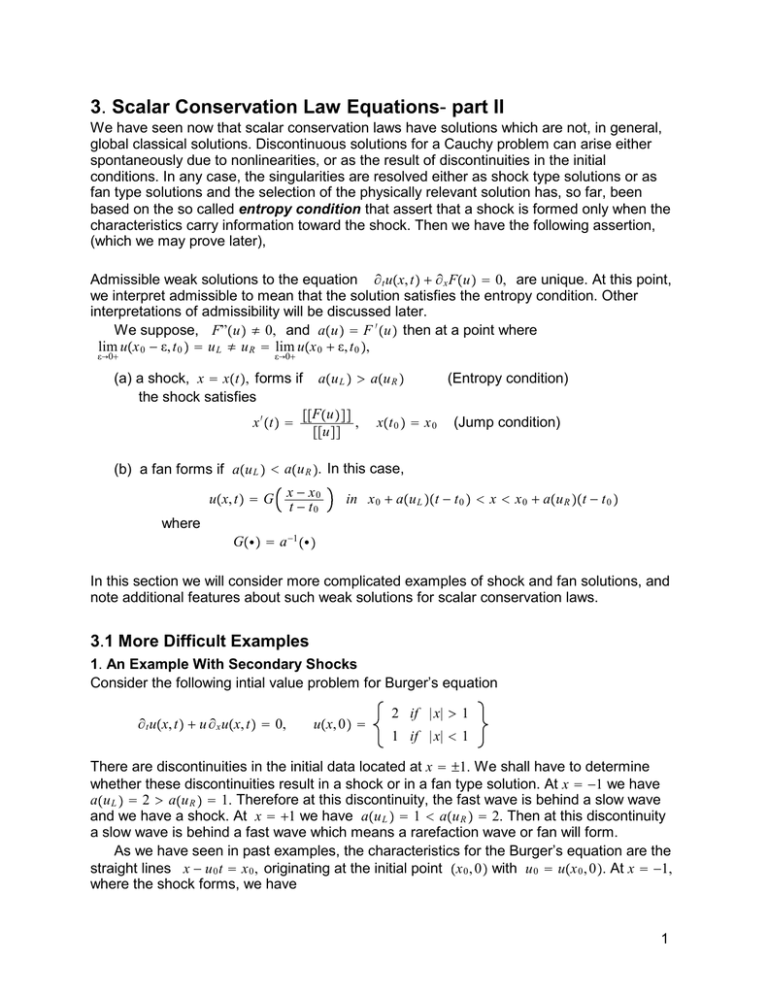
3. Scalar Conservation Law Equations- part II We have seen now that scalar conservation laws have solutions which are not, in general, global classical solutions. Discontinuous solutions for a Cauchy problem can arise either spontaneously due to nonlinearities, or as the result of discontinuities in the initial conditions. In any case, the singularities are resolved either as shock type solutions or as fan type solutions and the selection of the physically relevant solution has, so far, been based on the so called entropy condition that assert that a shock is formed only when the characteristics carry information toward the shock. Then we have the following assertion, (which we may prove later), Admissible weak solutions to the equation / t uÝx, tÞ + / x FÝuÞ = 0, are unique. At this point, we interpret admissible to mean that the solution satisfies the entropy condition. Other interpretations of admissibility will be discussed later. We suppose, F”ÝuÞ ® 0, and aÝuÞ = F v ÝuÞ then at a point where lim uÝx 0 ? P, t 0 Þ = u L ® u R = lim uÝx 0 + P, t 0 Þ, P¸0+ P¸0+ (a) a shock, x = xÝtÞ, forms if aÝu L Þ > aÝu R Þ (Entropy condition) the shock satisfies ßßFÝuÞàà x v ÝtÞ = , xÝt 0 Þ = x 0 (Jump condition) ßßuàà (b) a fan forms if aÝu L Þ < aÝu R Þ. In this case, where uÝx, tÞ = G x ? x 0 t ? t0 in x 0 + aÝu L ÞÝt ? t 0 Þ < x < x 0 + aÝu R ÞÝt ? t 0 Þ GÝ6Þ = a ?1 Ý6Þ In this section we will consider more complicated examples of shock and fan solutions, and note additional features about such weak solutions for scalar conservation laws. 3.1 More Difficult Examples 1. An Example With Secondary Shocks Consider the following intial value problem for Burger’s equation / t uÝx, tÞ + u / x uÝx, tÞ = 0, uÝx, 0Þ = 2 if | x| > 1 1 if | x| < 1 There are discontinuities in the initial data located at x = ±1. We shall have to determine whether these discontinuities result in a shock or in a fan type solution. At x = ?1 we have aÝu L Þ = 2 > aÝu R Þ = 1. Therefore at this discontinuity, the fast wave is behind a slow wave and we have a shock. At x = +1 we have aÝu L Þ = 1 < aÝu R Þ = 2. Then at this discontinuity a slow wave is behind a fast wave which means a rarefaction wave or fan will form. As we have seen in past examples, the characteristics for the Burger’s equation are the straight lines x ? u 0 t = x 0 , originating at the initial point Ýx 0 , 0Þ with u 0 = uÝx 0 , 0Þ. At x = ?1, where the shock forms, we have 1 ßßFÝuÞàà = ßßuàà x v ÝtÞ = Then xÝtÞ = 3 2 t ? 1, 1 2 u 2L ? 12 u 2R = ul ? uR 1 2 Ýu L + u R Þ = 3 2 , xÝ0Þ = ?1. t > 0, and uÝx, tÞ = 2 if x < 1 if x > 3 t ? 1, 2 3 t?1 2 At x = 1 there is a fan, bounded on the left by the characteristic x ? t = 1, and on the right by x ? 2t = 1. Between these two rays we have uÝx, tÞ = x ? 1 , t t + 1 < x < 2t + 1, t > 0. Now observe that the characteristic that forms the left boundary of the fan intercepts the shock line. That is 32 t ? 1 = t + 1 at t = 4, x = 5. At this point, the shock hits the fan (so to say). To the left of the shock line we have u L = 2, and to the right of the fan boundary we have u R = x ? 1 , and since u L > u R , a secondary shock forms. This secondary shock satisfies t x v ÝtÞ = 12 Ýu L + u R Þ = 12 2 + x ? 1 , xÝ4Þ = 5. t The solution of this intial value problem is x 2 ÝtÞ = 2t + 1 ? 2 t . Then the solution to the original Cauchy problem is, 2 uÝx, tÞ = 1 x?1 t 2 x< if if 3 2 3 2 t?1 t?1 < x < t+1 if t + 1 < x < 2t ? 1 if for 0²t²4 x > 2t ? 1 2 if x < t + 1 or x > 2t ? 1 2 x?1 t = for t > 4 if t + 1 < x < 2t ? 1 ? 2 t Clearly the secondary shock, x 2 ÝtÞ = 2t + 1 ? 2 t , never meets the far edge of the fan which is the line, x ? 2t = 1. 2. An Example With Nonconstant Initial Conditions Consider the following intial value problem for Burger’s equation / t uÝx, tÞ + u / x uÝx, tÞ = 0, 1 ? x if uÝx, 0Þ = 0<x<1 if x < 0 or x > 1 0 The initial condition is discontinuous at x = 0 but at that point we have u L = 0 < u R = 1 so there is no shock. Instead, a rarefaction wave originating at (0,0) develops and the solution for this part of the problem is, if x < 0, t > 0 0 x t uÝx, tÞ = if 0 < x < t, t > 0 For characteristics originating in the interval 0 < x 0 < 1, we have x ? u 0 t = x 0 , u 0 = fÝx 0 Þ = 1 ? x 0 and u = fÝx ? utÞ = 1 ? Ýx ? utÞ Solving this last equation for u leads to u= t + 2 t 2 + 4Ý1 ? xÞ , t ? 2 1 2 1 2 t 2 + 4Ý1 ? xÞ but only the first solution satisfies uÝx, 0Þ = uÝx, tÞ = t + 2 1 2 t 2 + 4Ý1 ? xÞ , 1 ? x for 0 < x < 1. Then we have for t < x < xÝtÞ, t > 0, where xÝtÞ is the equation for a shock which originates at (1,0) and is due to the following collision of solutions, uL = t + 2 1 2 t 2 + 4Ý1 ? xÞ > u R = 0. Then the R-H condition asserts that xvÝtÞ = 1 2 Ýu L + u R Þ = 1 2 t + 2 1 2 t 2 + 4Ý1 ? xÞ + 0 = 1 4 t + t 2 + 4Ý1 ? xÞ , xÝ0Þ = 1. This is a nonlinear ode for x(t) which is found by inspection to have a solution of the form xÝtÞ = k t 2 + 1 and substitution into the equation shows that k = 3 16 . We have then 3 uÝx, tÞ = Note that at t = t= 3 2 t 16 4 3 3 2 t 16 if x < 0 or x > 0 x t t + 2 +1 if 0 < x < t 1 2 t 2 + 4Ý1 ? xÞ if t < x < 3 2 t 16 0²t² 4 3 and x = 4 3 . +1 , the right boundary of the fan, x = t, meets the shock, x = + 1, so t = 4 3 3 2 t 16 + 1; . In view of the picture, we have u L = x > 0 = u R so a secondary shock forms. This shock must satisfy t x 43 = 43 . x v ÝtÞ = 12 Ýu L + u R Þ = 12 x + 0 , t Then x 2 ÝtÞ = 4t 3 and 0 uÝx, tÞ = x t if x < 0 or x > if 0 < x < 4t 3 4t 3 t> 4 3 . It is apparent from this example that when a shock forms between two regions in which the solution is constant, then the shock is a straight line. If the solution is nonconstant on either side of the discontinuity, then the shock curve will necessarily be curved. 3. An Initial-Boundary Value Problem Consider the following initial-boundary value problem / t uÝx, tÞ + 2u / x uÝx, tÞ = / t uÝx, tÞ + / x ÝuÝx, tÞÞ 2 = 0, x > 0, t > 0, 4 uÝx, 0Þ = 1 2 , x > 0, and 1 if 0 < t < 1 uÝ0, tÞ = 1 2 if t>1 Note that this is slightly different from Burger’s equation. We still have u = constant on characteristics but the characteristic equations, x v ÝtÞ = 2u, u v ÝtÞ = 0, lead to straight line characteristics given by, x ? 2u 0 t = C 0 . For a characteristic originating at a point Ýx 0 , 0Þ on the line t = 0, this becomes x ? t = x 0 , since uÝx 0 , 0Þ = u 0 = 12 . For a characteristic that originates at a point Ý0, t 0 Þ on the boundary x = 0, we get x ? 2t = C and C = ?2t 0 if 0 < t 0 < 1 and C = ?t 0 if t 0 > 1. Then x = 2Ýt ? t 0 Þ if 0 < t 0 < 1, but x = Ýt ? t 0 Þ if t 0 > 1. Evidently there is a discontinuity in the data located at Ý0, 0Þ where we have aÝu L Þ = 2 u L = 2 > 1 = 2 u R = aÝu R Þ Therefore, a shock forms, satisfying the equation x v ÝtÞ = u2 ? u2 ßßFÝuÞàà = u LL ? u RR = u L + u R = ßßuàà 3 2 , xÝ0Þ = 0. Then x 1 ÝtÞ = 32 t is the equation for the straight line shock originating at the origin. There is also a discontinuity in the data located at Ý0, 1Þ where aÝu L Þ = 2 u L = 1 < 2 = 2 u R = aÝu R Þ so a fan type solution must form in the wedge shaped region W = át ? 1 < x < 2t ? 2â. Since aÝuÞ = 2u, the inverse function is GÝuÞ = a ?1 ÝuÞ = 12 u and so uÝx, tÞ = G x t?1 = 1 2 x t?1 in W. Now it can be seen from the picture that the right boundary of the wedge, x = 2t ? 2, meets the shock x = 32 t, at t = 4, x = 6. At this point the solution to the left is greater than the solution value on the right so a secondary shock will form which satisfies 5 x v ÝtÞ = u L + u R = Then 1 2 x + t?1 1 2 , xÝ4Þ = 6. x 2 ÝtÞ = t ? 1 + 3t ? 3 , t > 4, describes the (curved) secondary shock and the global weak solution is, 1 2 uÝx, tÞ = 1/2 x t?1 1 if 0 < x < t ? 1, or 3t/2 < x if t ? 1 < x < 2t ? 2 if 0 < x < 3t/2 2t ? 2 < x < 3t/2 1/2 x t?1 1 2 for 1 < t < 4 if 0 < x < t ? 1, or x 2 ÝtÞ < x if 0<t<4 for 0 < t < 1 t ? 1 < x < x 2 ÝtÞ t>4 3.2 Equivalence of Conservation Law Equations If u = uÝx, tÞ is a smooth solution of the Burger’s equation / t uÝx, tÞ + u / x uÝx, tÞ = 0, then u is also a smooth solution of each of the following equations u / t uÝx, tÞ + u 2 / x uÝx, tÞ = / t Ýu 2 /2Þ + / x Ýu 3 /3Þ = 0, u 2 / t uÝx, tÞ + u 3 / x uÝx, tÞ = / t Ýu 3 /3Þ + / x Ýu 4 /4Þ = 0, _ n n+1 = / t ÝPÝuÞÞ + / x ÝFÝuÞÞ = 0. / t un + / x u n+1 These equations all have the form of a conservation law corresponding to density field PÝuÞ and flux field given by FÝuÞ. Then the R-H condition for the shocks for these equations reads, x v ÝtÞ = n+1 u n+1 FÝu L Þ ? FÝu R Þ L ? uR = n , n n n + 1 uL ? uR PÝu L Þ ? PÝu R Þ Ýn = 1Þ x v ÝtÞ = 1 2 Ýn = 2Þ x v ÝtÞ = 2 3 Ýu L + u R Þ, u 2L + u L u R + u 2R , uL + uR etc Evidently the equations for various values of n have the same smooth solutions but each has its own shock solution different from all of the others. Therefore, when studying the weak solutions of a given conservation law equation, it is not permissable to change the conservation law to a form which, for smooth solutions is equivalent since the form does not, in general, have the same weak solutions. 6 3.3 Transformations and Conservation Laws Consider the conservation law equation, / t uÝx, tÞ + / x FÝuÝx, tÞÞ = 0 Ý3.1Þ where F”ÝuÞ ® 0 so the equation is genuinely nonlinear. If we let vÝx, tÞ = F v ÝuÝx, tÞÞ then / t vÝx, tÞ = F”ÝuÞ / t uÝx, tÞ, and / x vÝx, tÞ = F”ÝuÞ / x uÝx, tÞ, hence F”ÝuÞÝ/ t u + F v ÝuÞ / x uÞ = / t vÝx, tÞ + v / x vÝx, tÞ = 0. Evidently this change of variable transforms the general conservation law (3.1) for u = uÝx, tÞ, into the Burger’s equation for v = vÝx, tÞ. If the solutions to these equations are smooth, then solving one of them leads to the solution of the other. However, there is no such equivalence for shock solutions to these equations since / t uÝx, tÞ + / x FÝuÝx, tÞÞ = 0 leads to x v ÝtÞ = FÝu L Þ ? FÝu R Þ uL ? uR while / t vÝx, tÞ + v / x vÝx, tÞ = 0 leads to x v ÝtÞ = 1 2 Ýv L + v R Þ = 1 2 ÝF v Ýu L Þ + F v Ýu R ÞÞ and, in general, these are not the same. More generally, consider the initial value problem for Burger’s equation in example 2.1.1. The shock solution here is given by 1 if x < uÝx, tÞ = 0 if x > 1 2 1 2 t Ý3.2Þ. t On the other hand, the transformation, v = e u , leads to / t v = e u / t u, / x v = e u / x u, and it follows that e u ß / t u + u / x uà= / t vÝx, tÞ + u / x vÝx, tÞ = / t vÝx, tÞ + Ýln vÞ / x vÝx, tÞ = 0 Ý3.3Þ vÝx, 0Þ = e if x < 0 1 if x > 0 . Since F v ÝvÞ = ln v, the shock relation for (3.3) is x v ÝtÞ = ßßv ln v ? vàà Ýe ln e ? eÞ ? Ý1 ln 1 ? 1Þ = = 1 e?1 e?1 ßßvàà and this is not the shock that is obtained by subjecting (3.2) to the change of variable, v = eu. The implication of these examples is that smooth transformations do not preserve weak solutions, even though smooth solutions are preserved by such smooth transformations. 3.4 Time Reversals for Conservation Laws We recall that the solution to an initial value problem for a linear first order equation can be 7 written as uÝx, tÞ = fÝdÝx, tÞÞ where f denotes a function determined by the initial data and d = const is an implicit representation for the base characteristics of the equation. Then is clearly possible to recover the initial state from the specification of the solution at any time after the initial time. On the other hand, for 0 < c < 1, consider the initial value problem / t uÝx, tÞ + u / x uÝx, tÞ = 0, uÝx, 0Þ = 1 x ? c/2 ?c 0 if x < ?c/2 if ?c/2 < x < c/2 if x > c/2 The solution to this initial value problem is easily found to be uÝx, tÞ = = 1 x ? c/2 t?c 0 if x < t ? c/2 if t ? c/2 < x < c/2 for 0 ² t ² c if x > c/2 1 if x < t/2 0 if x > t/2 for t > c Solutions for various choices of c are shown in the figure, Since the solutions for all choices of c, 0 ² c ² 1, are identical for t > 1, we observe that it is not possible, in general, to recover earlier states from later states when the solutions involved are weak solutions to nonlinear equations We can summarize some of the differences we have noted between linear and nonlinear initial value problems: Linear Problems ¾ for all smooth initial data, there is a smooth global solution ¾ the smooth solution is uniquely determined by the equation and the data and the solution is reversible in time, i.e, uÝx, tÞ = SÝtÞßuÝx, 0Þà, uÝx, 0Þ = SÝ?tÞßuÝx, tÞà ¾ discontinuities in the initial data propagate along characteristics ¾ solutions are invariant under smooth transformations and equivalent equations have the same smooth solutions 8 . Nonlinear Problems ¾ no global classical solution need exist, even for smooth initial data; global weak solutions exist but are not reversible ¾ weak solutions are not uniquely determined by the equation and the initial data, an additional selection principle is needed. ¾ discontinuities can arise spontaneously and are propagated along noncharacteristic curves called shocks ¾ weak solutions are not invariant under smooth transformations and equations which are algebraically equivalent need not have the same weak solutions 9
